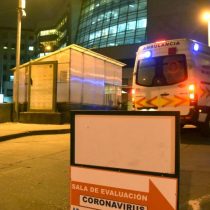
At a time when the country is moving towards a higher level of openness despite the pandemic, and the Metropolitan Region will advance to Phase 3 from Monday, it is not yet time to claim victory. This is confirmed by the scientific data, given that despite the sustained decrease in new cases of Covid-19, the occupancy of ICU beds remains high, according to the 49th ICOVID report, prepared by the University of Chile, the Pontificia Universidad Católica de Chile and the University of Concepción, with information obtained until Saturday, July 10, 2021.
At the national level, the burden has maintained a significant decrease during June and July, with an estimated number of new infections reaching 11.6 per 100 thousand inhabitants for the week analyzed (red color).
However, although the figures continue at critical values, there is a significant drop in infections in 14 of the country’s 16 regions, with the largest decreases in the south and south central zones: Metropolitana (-12%), O’Higgins (-15%), Maule (-12%), Biobío (-12%), La Araucanía (-23%), Los Ríos (-20%), and Los Lagos (-32%).
Regarding the transmission rate (effective R) it is between 0.8 and 0.88, maintaining the trend observed since June. “No region shows a value of this indicator significantly greater than 1, and 12 regions maintain this indicator significantly less than 1, the exception being Arica and Parinacota, Tarapacá, Atacama, and Aysén,” the report details.
Despite these figures, the academic and director of the Data Science Unit of the Department of Computer Engineering of the University of Concepción, Guillermo Cabrera-Vives, warns that “only the Magallanes Region has the indicator of infected new non-critical journals. The rest of the regions maintain over 10 new cases per day on average per 100 thousand inhabitants, indicating that we must continue with the successful vaccination campaign and take care of ourselves in general.”
PCR and traceability
At the national level, the total number of PCR tests reported per thousand inhabitants per week increases to 18.9 (equivalent to 2.7 daily tests per thousand inhabitants) compared to 18.0 the previous week.
There is also an increase in the number of tests in 14 of the 16 regions, while the proportion of positive tests in all regions decreases. Positivity decreased in the last week (4-10 July) to 4.9% nationally, with this decrease observed in all regions. No region is at a critical level (over 10%) in this indicator.
There are seven regions that are in orange level, seven in yellow level, and Tarapacá and Magallanes are in green level, that is, the indicator is below the risk threshold. In turn, Los Ríos (8.9%) and La Araucanía (6.8%), Atacama (5.7%), and Metropolitana (5.6%) they are the regions that have the most positivity.
In the dimension of traceability, the indicator of early consultation reaches 53% of achievement, remaining stable since mid-March. While the proportion of laboratory tests reported within 24 hours of medical notification continues its upward trend since the end of March, approaching 80% achievement nationally.
On the other hand, the early confirmation of cases (within three days from the onset of symptoms) reaches 53%, registering a sustained increase since the end of March, when it only reached 41% of achievement at the national level.
High occupancy of ICU beds
ICU bed occupancy nationwide is down from 93.8% to 92.1% on average this week. While nationwide occupancy shows a slight, systematic decline since the beginning of June, it remains high: nine regions remain above the critical occupancy level of 85%.
This decrease is caused by a drop in COVID-19 patients in the ICU. The proportion of ICU bed occupancy with COVID-19 patients reached 61.2% nationally, down from 66.7% last week.
Finally, the average weekly daily use of ICU beds (stock) shows a decrease for all age groups (-16.3% for people under 50, -8.7% for people between 50 and 69 years, and – 3.1% for people over 70 years). Through the week of June 27, COVID-19 mortality data show a decline in all age groups, including those over 70, from the previous week.
vaccination
The academic of the School of Public Health of the University of Chile, Alejandra Fuentes-García explica that “vaccination coverage for COVID-19 – as of July 11 – reaches 57.7% of the total population of the country. At the regional level, Magallanes, Ñuble and Valparaíso have the highest coverage, while Arica and Parinacota along with Tarapacá show the lowest proportions.”
In addition, Fuentes-García explains, the high number of people susceptible to contagion, along with other context factors, such as the presence of more contagious variants, closed environments during winter, relaxation of restrictive mobility measures and expected decrease in antibodies at this time of year, “keep the probability of epidemic outbreaks in the coming months high. Therefore, it is essential not to let our guard down and continue to maintain all self-care measures by acting proactively in the presence of suspected symptoms of COVID-19 or in the face of contact information for a case.”
Read the full ICOVID report here.





